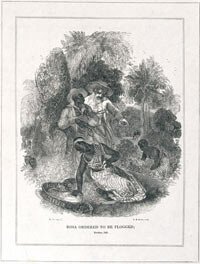|
The need for a large and steady supply of labour on the sugar plantations of the Caribbean and South America, and on the cotton plantations in North America initially led European countries to look to the West Coast of Africa to fulfil their labour requirements.
Most Africans supplied for enslavement in the Americas came from an area along Africa’s western coast that streched from Senegal in the north to southern Angola in the southwest. The questions as to why they were readily available, how many people were made available, and what effect their removal had on Africa and its development are varied and complex. Another question concerns the payments made by slave traders to those supplying them in Africa.
|
 © National Maritime Museum © National Maritime Museum |
The answer to the first question is that many African societies of the time were based on economies of subsistence and not on wage labour; therefore many people were tied to the land similar to serfdom in Europe. Although they were not chattel they were still obliged to provide services and goods commensurate with their skills. Some people were prisoners of war or criminals found guilty by their courts, most however were not. Other people were able to earn their liberty and change their status in society, and were not tied to privately owned land since this concept was unknown in many parts of Africa. This helps to explain why it was possible for many invaders and ‘settlers’ to establish communities in Africa over several centuries without serious challenge.
Answers to the other questions suggest anywhere from 10 to 15 million people captured, with many millions more lost to warfare associated with the trade.
The methods, reasons and consequences of capture have been dealt with elsewhere, but briefly, as prisoners of war or criminals with no gaols to house them, such people would be unwelcome, bearing in mind that prisoners of war would be considered foreigners and criminals might be considered particularly untrustworthy in societies that were for the most part based on honour, honesty, mutual cooperation and sharing.
 © National Maritime Museum
© National Maritime Museum
|
It is also informative to note that the depopulation of some African societies had become a problem as early as 1526 as expressed by King Nzinga Mbemba of Kongo in a letter to the Portuguese. It is interesting that he was powerless to do anything about it.
The other captives’ labour and skills would be useful as means of exchange in cashless economies as previously stated. It is questionable to what extent African leaders had knowledge of how their people might be used use in the Americas. They did not have the ships with the capacity to travel to the Americas or the technologies to build or navigate the oceans; therefore their knowledge of what was happening to their people would be debatable.
The final question is what goods were made in exchange for captives? The impetus for the slave trade came from the need for labour and the cash profits engendered from it. ‘Profit’ was therefore determined by the European slave traders’ ultimate return on the goods they purchased in Europe for the products they sold in Europe like sugar, rum, tobacco, etc.
|
The goods that Africans found useful included iron bars and tools, copperware such as basins, cotton textiles, glass beads manufactured in Venice and used in trading in enslaved Europeans between Europeans and Arabs, trinkets, muskets, ammunition and gunpowder. Firearms were insisted upon as articles of trade because they were seen as the source of the slave traders’ power and a potential threat to their own existence and were desired as much for protection from Europeans as from other African enemies who undoubtedly would also be supplied with them. Alcohol and horses were also traded.
Barter was the process by which goods and captives were exchanged and Europeans found that Africans were quite skilled in this method, but they often found it difficult to calculate what their profits might be at the end of the many months of the triangular trade cycle. Some of the goods involved in these transactions were cheap and inferior substitutes of those the Africans already produced for themselves such as cotton fabrics like printed calico and chintzes, and metalwork. This had the effect of undermining local production and accelerated the decline in the economic and productive infrastructure of those societies.
Eventually, a method was devised in the seventeenth century whereby a slave trader was able to reckon his profit on the exchange more easily. This was the ‘trade ounce’ in which the cost of a package of various items was related to an ounce of gold, perhaps fifty percent, in order to allow for a one hundred percent profit. With this in mind the slave trader was able to have a fixed monetary value in mind and be able to calculate the value of his cargo.
|

